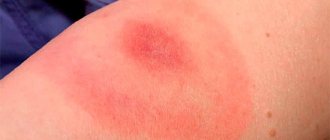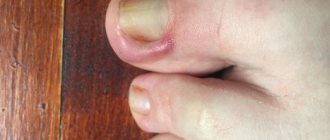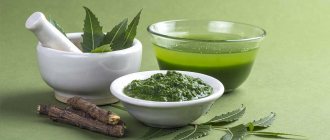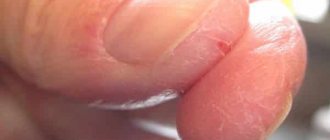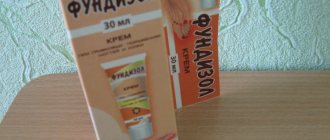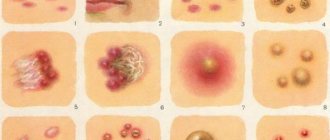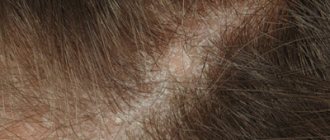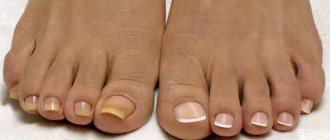Rating: No rating
For most girls, gel polish is a miracle product that guarantees perfect condition for hands for two weeks, pleasing the eye with the freshness of the manicure and resistance to all external influences. But along with obvious advantages, it has a serious drawback . This is evidenced by many unpleasant photos with traces of irritation, redness, blisters in the nail area caused by an allergy to the substances included in the gel polish and its auxiliary products.
What is gel polish?
The combination of a coloring substance (varnish) and a substance for nail extension (gel) made it possible to launch a product called gel polish on the market. This is a relatively new means of adding beauty to nails, which has undeniable advantages:
- quick drying;
- long-lasting effect (3 weeks guaranteed durability);
- strength of the nail plate due to the coating layer.
Among the disadvantages of this product is its synthetic composition. If the quality of the product is questionable, there is individual susceptibility, or the technology for performing the procedure has been violated, then the likelihood of an allergic reaction increases many times over.
Reviews
Numerous reviews from women point to the fact that an allergic reaction is possible to any cosmetics, including varnishes.
However, the majority of negative reviews are caused by Bluesky gel polish, made in China, although the packaging states that the composition of Chinese Bluesky and SND, made in America, are identical. This product contains many harmful substances. Under their influence, even an allergy to hairspray develops. Its composition has a lot in common with gel nail polish.
Many ladies leave positive reviews about the Emi nail polish collection. They are very bright, rich and durable. There are practically no side effects when using these varnishes. According to the majority, Emi is the best company with a high level of quality.
Compound
Gel polish contains artificial ingredients, each of which can be an allergen for the body:
- pigment component - a coloring substance that is responsible for the brightness of color;
- photoinitiator – these are substances that allow the coating to harden;
- film former – a substance that creates a coating on the nail that is dense and resistant to mechanical stress;
- thinners and other additional substances that create a suitable consistency convenient for application to the nail plate (including acrylic acid esters).
In addition to the main additives in the coating composition, those that provoke allergies may be present:
- diacetone alcohol;
- phenyl ketone;
- butyl acetate;
- nitrocellulose;
- phosphoric acid.
Each of these substances is an allergen. Together they create a complex mixture of synthetic substances, which is very difficult even for an experienced allergist to understand and determine which one is the source of the allergy. In addition to the main gel polish, a base layer and a topcoat, also made from artificial components, are applied to the nail plate.
For your information! The more layers applied to the nail, the higher the likelihood of an allergic reaction and contact of any of the drugs with the skin.
How can you replace gel polish if you are allergic to it?
To avoid recurrent allergies, you need to replace the varnish with an alternative hypoallergenic product with less toxins. But the best recommendation in this case would be to rest your fingers from any materials for at least a month for overall strengthening of the body.
Then you can carefully move on to medicinal or regular varnishes , which, after coating with gloss, are difficult to distinguish from the gel. But if you are prone to an allergic reaction to any ordinary gel polish, a good master will always be able to recommend a better one, to which you are not allergic:
- CND Vinylux does not require drying with a lamp and lasts for a week.
- CND Shellac - an expensive and less toxic version of gel polish.
- Red Carpet It very rarely causes allergies, as it is easy to apply and remove.
- Hypoallergenic American varnish Cuccio Veneer.
These varnishes have helped many girls avoid allergies from gel polish on their nails and fingers, but do not forget about the individual characteristics of each organism.
Allergies when drying and removing the coating
In addition to an allergy to gel polish, a negative reaction of the body to the coating remover or UV radiation to which the hands (or feet) are exposed when drying is possible.
Allergy to UV radiation
This is a very rare case of an allergic reaction, which can occur in extremely sensitive skin. Determining the cause of the allergy (gel polish or exposure to a lamp) is very difficult. In addition, there is a possibility that exposure to ultraviolet light is not an allergen in itself, but triggers complex processes in the body that cause an allergic reaction.
Allergy to gel polish remover
Nail polish remover is also a synthetic product. It contains:
- acetone (or its effect analogs);
- alcohol;
- silicone;
- vitamins;
- oils, such as lemon or tea tree;
- glycerol.
When working with gel polish remover, it is almost impossible to avoid chemicals getting on your skin. According to the technology of the procedure, a sponge with a solvent is applied to the nail plate and fixed with pieces of foil or special clips. At the same time, air ventilation is reduced, which also contributes to allergic manifestations.
Severina Cleaner degreasing and sticky layer remover – review
Good day!
My acquaintance with Severina began about a year and a half ago, when my friend was finishing learning manicure, and I was her guinea pig, she used Severina to remove the sticky layer, I was happy with everything, there were no bad feelings after use.
What does the jar look like:
It is not expensive, but I do not advise you to play with your health.
About two months later, I myself bought a UV lamp, varnishes, files, nippers, brushes, etc., including a liquid for degreasing and removing the sticky layer + a special gel to remove varnish.
And all this was released by Severina. Yes, at first everything suited me, I really liked and enjoy fiddling with my nails, giving myself a manicure, but in December 16, trouble happened to my fingers.
I immediately started looking for similar symptoms on the Internet, in public pages, etc. Everyone wrote the same thing: “this is an allergy to shellac.” Then I also counted, but... how wrong all these girls were and how wrong I was. This is not an allergy to shellac ( I will explain why below, with all the photographs, etc. ), this is precisely a chemical burn.
Let's figure out what chemicals are. A burn is damage to various body tissues due to the aggressive effects of chemistry (chemical substances.
) A chemical burn can be caused by any means, even with green paint or iodine, and there are so many cases where girls dyed their hair (most often it’s ammonia, blond/lightening dyes.
) overexposed the dye to their hair and, consequently, lost their hair, or it took a very long time to restore the scalp.
So, why a skin reaction to severin cannot be called an allergy:
1. If you are not allergic, in most cases you cannot just acquire an allergy. Example: My friend’s mother has an allergy to flowers, but her daughter did not have an allergy until she was 19, and then it appeared.
2. The main area affected by this very “shellac allergy” is the skin , not the nails ! If you were allergic to the gel, in this case, your nails would deteriorate and be the source of damage to this very allergy, but not your skin, especially if the varnish did not get on it!
3. Allergies are always extinguished by anti-allergy drugs - Suprastin, Erius, etc. When this all happened to me - not a single anti-allergy drug helped me, I will say more, the effect was simply zero, I was drinking these pills in vain. (both before and after a manicure, and during skin lesions.)
4. The burns were only on the first phalanges of the fingers; they did not spread further. And allergies most often like to affect different parts of the body.
About the symptoms: after completing the manicure, after about half an hour/hour, terrible itching appears.
It’s impossible to overcome yourself and not scratch your hands, I rubbed them, tried not to scratch them, but everything was in vain and small bubbles appeared, barely noticeable, a la urticaria, but, I want to say right away, they don’t always appear.
the next step is that the fingers swell a little, although I would not say that it is the next step, sometimes they did not swell at all, or only a couple of fingers swelled.
Literally after 3-4 days, the skin looks as if you came out in 30 degree frost with wet hands (not your hands, but only wet the first knuckles of your fingers). Creams for dry skin, special creams in the form of levomikol and d-panthenol do not help at this moment! No need to waste money. The pads of the fingers burst and it is very, very painful.
This is what happens next - the skin begins to peel off, your hands hardly itch, but the fact that your fingertips are constantly cracked and can bleed does not give you peace. I think you understand how painful it is.
What I highlighted for myself: don’t stuff yourself with pills, you’ll only end up wasting your time!!! This will not help you one bit, lubricate your hands more often with ordinary creams, like Nivea, it will not give a huge result, but it will soften the skin at least a little.
Or buy Propolis ointment, it will relieve the itching a little! Also, you can apply something cold; personally, I have creams (even Nivea) in the refrigerator - this helps a lot. But when the skin begins to peel off slowly, levomikol and d-panthenol help.
And, most importantly , what I thought of recently - buy yourself Panthenol in the form of foam! Firstly, it cools, secondly, it relieves a little itching, thirdly, IT WILL JUST MAKE YOUR LIFE EASIER.
I have encountered such a burn more than once, because for a long time I tried to find out what was killing the skin.
I also sinned on varnishes, changed everything to other companies - everything was the same, I sinned on the UV rays from the lamp - I hid my fingers in gloves, so that only my nail was visible - everything was the same, I changed everything except severina until recently. As soon as I removed it from my “diet”, everything stopped.
You can replace it with another brand, or replace it with boric acid (also degreases and removes the sticky layer), or buy a regular nail polish remover in the store, the same thing will be in the form of a degreaser and remover.
And, by the way, severina is first on the list of chemical substances and chemical burns!
Well, let’s take it in order in the form of a photo report about the symptoms and what it all looks like (sorry, I didn’t seem to take a photo of how it all looked on the pads. If I suddenly find it, I’ll add it later, or search on the Internet, you’ll definitely find it.):
These are the nails after that ill-fated manicure, as you can see, the index finger is slightly swollen and + redness has formed:
But here’s a photo a week later, I’ll answer frequently asked questions right away: no, this is not damage from the clippers, I don’t touch my skin with clippers at all while I’m getting a manicure. No, I didn’t remove the burrs, it all follows from this very chemical. burns (even worse):
It was already the next manicure, I was still looking for what was playing out on the skin of my hands like that. I’ll say this: after 2-3 weeks the symptoms went away and I just had to restore the skin with creams and oils + you can see a little of what’s left of all this:
And so, two months ago I went with panthenol, which helped me a lot:
Don't skimp on the foam; I also sprayed it on the palm side. And, also, give your nails a rest.
Yes, it would be possible to remove the polish on the same day as soon as the symptoms began, but! The skin is already affected by severina and this will not help you (I tried it too). By the way, then I somehow got into a conversation with my mother’s friend (and she is a dermatologist) and she confirmed to me that it was a chemical burn, and not an allergy.
And a month ago I excluded severina and did my own extensions, this photo is a few days later, as you can see, there are no symptoms:
I hope my review was useful to you and you don’t face the same trouble as I did! Take care of your health.
Have a nice day and good mood! Well, a chic manicure without burns
Source: https://irecommend.ru/content/skazhem-khimicheskim-ozhogam-na-paltsakh-privet-khotite-ugrobit-svoi-manikyur-v-mig-severina
Symptoms
An allergic reaction itself is a response of the immune system to contact with a certain substance. In case of such manifestations from the use of gel polish, the following options are possible:
- respiratory reaction;
- contact allergy.
Contact allergy
If gel polish gets on the skin, a reaction is possible that spreads only within the hands or feet (if permanent coating of toenails was done). No manifestations of the reaction should be observed on other parts of the body. The exception is, for example, accidental splashes.
Allergic manifestations:
- peeling on the fingers;
- dry skin;
- red rash;
- blisters;
- redness;
- burning;
- itching;
- separation of the nails from the bed (in rare severe cases).
Manifestation of allergies to gel polish on hands (photo examples)
The photo shows the symptoms of an allergy to gel polish on the fingers
Nails react to gel polish removal (photo example of an allergic reaction)
Such manifestations cause discomfort and change the appearance of the hands.
Important! If you suspect an allergy, it is recommended to consult a doctor, as fungal infections, eczema, scabies and others may have similar symptoms.
Respiratory response
Gel polish fumes inhaled by a person can also cause an allergic reaction, which may have the following symptoms:
- hard breath;
- swelling of the lips, tongue;
- cough;
- sore throat;
- lacrimation;
- redness of the eyes;
- swelling of the eyelids.
The danger of respiratory manifestations lies in the progression of manifestations. The most dangerous of them is Quincke's edema.
Restoring damaged fingers and nails
To restore the skin on your fingers and nails, it is recommended to follow some rules:
- The first step is to eliminate the allergen. Contact with gel polish is prohibited; nail polish remover should not come into contact with your fingers, as it contains a lot of chemicals. They will make the condition worse. It is better to refuse manicures.
- The skin of your hands and fingers must be lubricated with moisturizing creams.
- Herbal baths are performed at least twice a week.
- Wash your hands with soap without fragrances or dyes so as not to worsen the condition.
- You need to take vitamins A and E. They will help you recover faster.
- Painful areas should not be rubbed or scratched, as this will make them heal more slowly.
- Ointments prescribed by a doctor are regularly applied to the damaged areas.
If the damage was severe, the patient experienced onycholysis, it is recommended to take the drugs Ketoconazole, Fluconazole, which help restore the nail plate and strengthen it.
In this case, sea salt baths are also suitable. To prepare it, mix a tablespoon of salt and 500 ml of warm water. Hands are kept in the resulting solution for 20 minutes, the procedure is carried out twice a week.
These measures will help the nails and skin on your fingers recover faster.
Treatment
The first step in case of a diagnosed allergic reaction to gel polish is removing the coating. Further treatment includes a set of measures:
- taking oral antihistamines;
- external use of drugs (antihistamines, hormonal);
- use of moisturizing creams and emulsions.
For your information! Preparations for internal and external use must be prescribed by a doctor.
Oral agents
Antihistamines that are most often prescribed:
- Loratadine;
- Suprastin;
- Tavegil and others.
Usually the treatment is not long-term - literally up to three days are enough if the situation is not advanced.
External means
The doctor prescribes hormonal ointments in cases where the diagnosis is confirmed and the presence of a fungal or bacterial infection is completely excluded.
External agents have the following effects:
- eliminate blisters;
- treat rash;
- relieve inflammation;
- eliminate itching.
Among the popular, well-proven medications:
- Akriderm;
- Advantan;
- Elokom and others.
Non-hormonal drugs for external use:
- Fenistil;
- Gistan et al.
Treatments for respiratory allergies
If the allergy develops rapidly and there is difficulty breathing, it is recommended to call an ambulance. Before doctors arrive, you must take an antihistamine in tablet form.
For minor manifestations of the nasal mucosa, you can use, for example, Sanorin Analergin .
What to do when the first symptoms appear?
When the first symptoms appear, you must stop using gel polish.
If possible, it is recommended to remove it from the nails.
Then, to relieve symptoms, it is recommended to take antihistamines:
- Tavegil.
- Suprastin.
- Zyrtec.
- Claritin.
One tablet is usually enough to relieve the patient's condition. After taking the medicine, you need to monitor your condition . If the allergy begins to disappear, stop taking antihistamines.
Do not use gel polish anymore, as the symptoms will reappear when applied again. If the symptoms do not go away, the condition only worsens, you should immediately visit a doctor who will prescribe the optimal treatment method.
↑ to contents
Prevention
The best way to prevent allergies when using gel polish is to refuse to carry out the procedure in the future.
For those who want to have their nails covered, and the price of the procedure is not particularly important, it may be recommended to use products from an expensive segment that position themselves as hypoallergenic. But even in this case, you cannot be completely sure that the allergy will not manifest itself.
Tips to help avoid a reaction to gel polish:
- Do the procedure in a special salon, not at home
- Proper storage of all components, avoid hypothermia, overheating or exposure to sunlight
- Prevent gel from getting on your hands
- Use medical masks to prevent vapors from entering the body
- After the procedure, wipe the bottles with an alcohol solution
- After manicure, wash your hands thoroughly with soap and water.
If the use of gel polish causes an allergic reaction, it is necessary to undergo a course of treatment and recovery. And in the future, be attentive to the selection of household chemicals and cosmetics in order to prevent the recurrence of unpleasant situations associated with allergies.
Reviews about allergies to gel polish
Can girls who are not prone to allergic reactions be allergic to gel polish? Numerous reviews from all those who have experienced its unpleasant symptoms convincingly say.
Tatyana, 24 years old
I used gel polishes for almost a year, the design and quality of which were wonderful, but after the last coating the skin around my nails became swollen and cracked, I decided that these were signs of some kind of dermatitis, but it turned out to be an allergy to the gel polish. I really don’t want to give up such a cool procedure.
Specialist comments: Tatyana will have to undergo a course of treatment and rehabilitation, after which we recommend trying to switch to less harmless original varnishes of the CND series.
Oksana, 32 years old
I was very upset when, after yet another extension and coating with gel polish, my fingers itched near my nails and there was redness, but then everything went away. I told the master about this, and the next time we changed the polish, but it didn’t help: in the morning the skin around the nails was swollen and covered with blisters. It was very painful and took a long time to heal, I had to undergo a long treatment course for an allergy to gel polish, and the dermatologist categorically forbade using it as a coating. For now I get a manicure at the salon and apply only medicinal varnish.
Expert's comments: With the current variety of colors and textures of durable high-quality varnishes, bases and fixatives, you can choose an excellent option on the advice of a specialist.
Elena, 27 years old
I am an experienced allergy sufferer, so when I wanted to try gel polish on my nails, I was wary of it. But I have a very smart manicurist, and she suggested that I try American CND. It suits me very well, and I have been using this product for three years now src=»https://www.joxin.club/wp-content/uploads/2017/10/allergiya-na-gel-lak-otzyvy-3-min.jpg "class="aligncenter" width="660″ height="377″[/img]
Expert's comments: The example is very illustrative, and the varnishes of this well-known company are indeed less toxic and of very high quality. But this absolutely does not mean that this is a panacea for everyone who is allergic to gel polish, since everything is very individual.
Of course, I really don’t want to deprive myself of such a convenient and beautiful procedure as gel polish coating because of an allergy, but those who have encountered this problem have already understood what discomfort it brings into our lives. Therefore, knowing its characteristic symptoms, you should not experiment again with your health and look for worthy alternative options.
Dangerous brands and manufacturers that are best avoided
As practice shows, the most dangerous manufacturers are Chinese, since their products contain the substance methacrylate. It leads to nail detachment and inflammation of the skin around the nail plate.
Such gel polishes are usually of lower quality and cheaper . In addition to the substance methacrylate, they contain many chemical components that can lead to a severe allergic reaction.
Experts name the most dangerous brands of gel polishes:
- Civi.
- Cristina.
- Bluesky.
- Canni.
There are brands that do not cause allergies, but they usually cost more.
↑ to contents
Allergy to Shellac: what to do and how to treat?
The innovative nail coating Shellac has long been an alternative to conventional varnish. It has a lot of advantages: no odor, formation of a smooth surface, stable, long-lasting results. Gel polish is easy to apply, dries quickly under a special lamp, and does not smudge. To remove, you do not need to file your nails, and under the influence of gel polish they even strengthen and become more durable. It is not surprising that many girls and women prefer shellac to regular manicure.
But with all the advantages of this coating, allergies to Shellac often occur. This is the body’s reaction to the chemical components included in the gel polish, including phosphoric and citric acid, diacetone alcohol, nitrocellulose, hectorite, butyl acetate, phenylketone, methacrylate. And although manufacturers claim that the product does not contain dibutyl phthalate, toluene and formaldehyde, allergies can be caused by a component such as methacrylate.
The most interesting thing is that the drugs that contain it are officially prohibited in many countries. But they still use it, because it is this substance that, when polymerized (heated under a UV lamp), ensures the durability and duration of the coating.
Content
How does an allergy to shellac manifest?
Faced with an allergic reaction of the body to shellac, scientists conducted research. It turned out that almost every fifth woman experienced allergy symptoms. Moreover, they were not only among the clients who applied it, but also among the craftsmen who, in one way or another, came into contact with shellac.
Reactions to methacrylate can range from minor rashes to serious and dangerous consequences. This is very typical for allergies; in addition, the severity of the manifestations depends on the state of the body's immune system. The simplest thing that could happen is hives in the area around the nail. First there is itching, and then small blisters appear. They constantly itch and cause discomfort.
In more severe cases, the hives may spread further down the fingers. They swell and a herpes-like rash appears on the palms: it also provokes itching. The blisters darken over time, dry out and turn into dark pigment spots that are difficult to remove. Or they form small lesions similar to lichen. The allergy also affects the nail plate: it becomes flaky and can even completely peel off from the nail bed.
Methacrylate can also cause angioedema. This is the same urticaria, but it affects the nasopharyngeal mucosa. It swells, similar rashes appear on it, and the swelling makes it difficult to breathe. This condition is critical for the body and requires immediate medical attention. The most dangerous reaction is anaphylactic shock.
How is an allergy to shellac treated?
However, it is worth considering that the percentage of severe manifestations of allergy to methacrylate is very small. Most often there is itching, rash, swelling of the finger around the nail, and detachment of the plate. What to do if you are allergic to Shellac? Doctors recommend completely eliminating contact with the allergen first. This means that the covering will have to be removed and not used until it is completely cured. Then you can carefully try to apply it again. But doctors do not advise doing this, because if the body reacted in a similar way once, the same thing will happen in the future. So you'll have to switch to regular varnishes.
If you notice any of the above symptoms, you should seek help from a doctor. He differentiates allergies from other diseases, for example, dermatitis, scabies, prescribes therapy and gives detailed recommendations on how to treat an allergy to Shellac. Self-medication can be dangerous and ineffective, especially if not only the fingers are affected, but also the palms, the area of the arms above the hands, the face, and the mucous membranes of the eyes. Therapy includes the use of antihistamines in tablet form. For external use, the doctor will prescribe ointments or creams with hormones and corticosteroids.
And you will have to give up shellac coating and buy varnish with a natural composition. Many women think that allergies are caused by a product from a specific manufacturer. This is an erroneous opinion: the composition of gel varnishes is the same, the only difference is in the degree of purification of the polymers. This means that any of them can cause an allergy.
Allergy to UV lamp
This article will touch upon a very progressive field of activity - cosmetology. Recently, cases of allergies have become very frequent in women who use a fairly common service - nail extensions.
Causes of allergies to UV lamps
What is the reason for such an unusual reaction to a fairly simple cosmetic procedure in a salon - gel nail extensions? After all, more and more women are doing gel nail polish to keep them in shape and beauty for a long time.
Allergic skin reactions to cosmetic products occur through the negative influence of certain ingredients that the human body perceives as foreign and harmful. Thus, we are talking about allergens. It should be emphasized that cosmetic allergens can be both products of natural and artificial origin.
When using them, some clients will have a positive reaction, while others will experience changes like one of the types of allergic reactions. This reaction appears immediately after contact with the allergen or after a certain time (if the required amount of allergenic ingredients accumulates in the skin substance).
How does an ultraviolet lamp affect the human body?
A common allergic reaction is the body's reaction to the use of an ultraviolet lamp for artificial nail extensions. The point is that the recommended gel for this procedure is viscous and at the same time waterproof.
An allergy to a UV lamp occurs through this very light-sensitive gel. An ultraviolet lamp acts on the substance as an activator: under the influence of ultraviolet rays, the gel is activated and at this moment the adhesion of gel molecules begins, which lead to hardening of the material, that is, the nails being extended.
This gel, remaining on the skin, leads to an overdose through prolonged exposure. So, in general, we are talking about overexposed cosmetic material, which is enough to cause a negative response from the human body. To do this, just touch the cuticles (dry tissue) a little with a device for applying ultraviolet gel.
What harm can an ultraviolet lamp cause?
Recent scientific studies have proven that the allergic reaction of the female body to exposure to ultraviolet radiation during artificial nail extensions is the root cause of cancer in them. An allergy to ultraviolet lamps has proven to be very harmful and extremely undesirable for those beauty lovers who are hypersensitive to cosmetic skin care procedures.
A UV lamp negatively affects the natural properties of human skin: its cells stop producing the required amount of substances for regeneration, so lovers of gel nail extensions risk aging faster than fans of the natural beauty of their body.
Why is UV lamp still widely used in cosmetology?
The problem with denying evidence of the harmful effects of using an ultraviolet lamp is that it is inexpensive, easy to purchase, and therefore almost every beauty salon is already equipped with such equipment. An ultraviolet lamp is used to harden a special ultraviolet gel that is ultra-sensitive to ultraviolet rays and secure the newly extended artificial nails.
Another advantage of the ultraviolet lamp is its fast, almost instantaneous effect on the gel used for extensions. Convenience, speed, ease of use, and ease of carrying out these procedures at home so far cancel out the reproaches of scientists and those who have already suffered from an allergy to an ultraviolet lamp.
How to tell if you are allergic to ultraviolet rays
A bad indicator is that such an allergic reaction of your body is not so easy to determine, and even more difficult to study and understand its causes.
An allergy to a UV lamp is determined by carefully examining the skin cells that are severely damaged by these powerful rays. Such a reaction of the body can occur immediately after the completion of the nail extension procedure or some time after it, in accordance with the strength of the ingredients from which this or that gel is created.
If you do not have a reaction immediately after completing artificial nail extensions, then this is not yet a reason to rejoice, since the gel used for this cosmetic service consists of a huge number of different components of different nature, which cause corresponding reactions in the body in the form of rashes, blisters, and itching.
In the photo: Blisters on fingers from allergies to UV lamps
It is possible that your body will need several sessions of irradiation to develop an allergy to an ultraviolet lamp.
How to cope with an allergy to an ultraviolet lamp
Scientific research proves that those women who visit nail salons less often and use their regular services are less at risk of various allergic reactions.
If you experience an allergy to an ultraviolet lamp, the first thing you should do is ensure that your hands are hygienically clean and immediately consult a dermatologist.
You cannot self-medicate (apply various medicinal and cosmetic oils, remove extended nails, dust them, trim pieces of the cuticle), since a complex allergy to a UV lamp can affect areas of the matrix of the skin, which is why nails can grow crooked for the rest of their lives.
Video: Which lamp is better to choose
Sources: , ,
No comments yet!
Comment for “Fingers itch after gel polish - negative experience”
As soon as I started reading the article, I was a little disappointed because of the phrase “allergy symptoms do not appear immediately, but after several months or years.” In my opinion, this is not a very correct formulation. If an allergy occurs, it will most likely be immediately, because the products do not contain natural ingredients, but chemicals. And “in a few years” means the allergen must constantly accumulate in the body. Otherwise, all the reasons are described perfectly, and the recommendations for preventing allergic reactions are also useful. Thanks a lot.
I myself use Vera Nail gel polishes; they have never caused allergic reactions in me or my clients. When I was just learning how to coat, the base hit the side roller a couple of times. It was quickly removed and no traces remained. And the base was Base Coat VeraNail, with a pumped-up composition? for better adhesion of nail polish to the nail.
Add a comment Cancel reply
You must be logged in to post a comment.
What does an allergy occur to?
In order to become an excellent manicurist you need certain knowledge, tools and materials, and most importantly - a great desire! But even with the above, not everyone can afford to realize themselves in this profession.
Indeed, due to such an unpleasant and very common diagnosis in our time as an allergy in a nail technician , many talented individuals had to leave their careers in the field of nail aesthetics.
Why does a manicurist develop an allergy, how to treat it, and can it be completely avoided? Let's take a closer look.
Fingers itch after gel polish - negative experience
A manicure with gel polish looks bright, lasts a long time and is easy to remove. But, despite all its advantages, gel polishes have a drawback - they can cause allergic reactions.
Most often, allergy symptoms do not appear immediately, but after several months or even years.
Women with dry and sensitive skin on their hands are primarily at risk. And those who wear the coating without interruption, as well as craftsmen who work with gel and other related materials every day.
Why do your fingers itch after gel polish? Let’s look at the main reasons.
